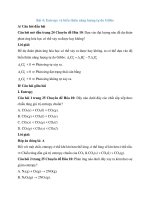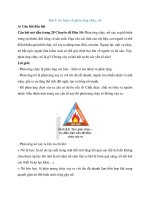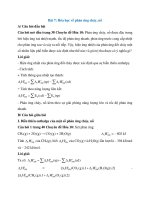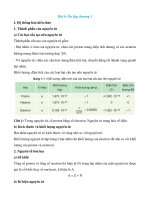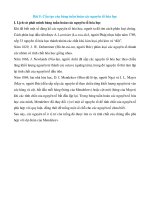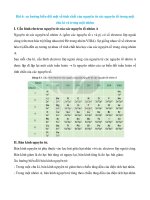giao an tieng anh 6 bai 15 tiet 5
Bạn đang xem bản rút gọn của tài liệu. Xem và tải ngay bản đầy đủ của tài liệu tại đây (90.04 KB, 2 trang )
UNIT 15: COUNTRIES
Lesson 5: C. Natural features (C3,4)
(Page 165)
Aims: Help Ss to improve some skills: reading and writing
A. Objectives: By the end of the lesson, Ss will be able to know clearly
about natural features in VN and in the world.
B. Language content:
*Vocab:
geogaphy words.
* Grammar:
comparative and superlative.
C. Preparations: Text-book, lesson plan, cassette, disc
Ways of working: T-WC, individual-work, pair-work.
Anticipated problems:
D. Procedure
I/ Organization: (1') - Greeting
- Checking attendance
II/ Warm-up: (7')
-Ask Ss to give the rules of comparision and examples.
III/ New lesson(35')
Contents
Teacher’s activities
Students’ activities
1. Presentation. (9')
+The Mekong River is
-Aks Ss to compare the -Give comparative:
longer than the Red River. Red River and
+ The the Red River is
Mekong River.
longer than Mekong River. -Correct Ss’ mistakes. -Comment.
Vocabulary.
flow (v): chảy
-Present some words. -Note down.
sea (n): biển
-Help Ss to read.
-Listen and repeat.
2. Practice. (13')
C3. Listen and read.
-Play the tape.
-Listen.
Then answer the
qs.
-Help Ss to read the
-Listen and repeat
a.- The longest river in VN is difficult words.
three times.
Mekong River.
Gulf of tonkin
- Mekong River is the
Tibet.
longest river in VN.
Nile River
b. The Mekong River starts
North Africa
in Tibet.
Mediterranean Sea
c. The Nile River is the
-Ask Ss to read the
-Read the text before
longest River in the world. text.
class.
d. The Nile River flows into -Guide Ss answer the -Ask and answer in
the Mediterranean Sea.
qs. Notice the qs with pairs.
e. Mount Everest is the
“which”
highest mountain in the
world.
f.- The highest mountain in
VN is Panxipang.
- Panxipang is the highest
mountain in VN.
3. Production. (13')
Practice freely.
-Correct Ss’ mistakes. -Comment.
-Ask some Ss about
their classmates, use
“which” and “who”.
+Who is the best
student in your
class?
+ Which schoolbag is
the newest?
-Let Ss do the same.
-Ask Ss to read 6
sentences in C4.
C4. Remember.
many
S+ have/has + a lot of
lots of
+ Ns
much
S+ have/has + a lot of
lots of
+N
-Answer T’s
questions.
-Ask and answer the
same.
-Read loudly before
class.
-Notice the usage of
some quantifier with
nouns.
-Listen, note down
and remember.
-Ask Ss to give
examples.
-Give sentences.
Notice “There is/are”.
-Check and correct.
-Comment.
(uncount)
Eg:
1.- There are many/ a lot of/
lots of students.
- My class has many/ a
lot of/ lots of students.
2.- There is much/ a lot of/
lots of new knowledge.
- A lesson has much/ a
lot of/ lots of new
knowledge.
.....
.....
.....
IV/ Consolidation (1')
- Review the main points.
V/ Homework (1')
- Learn by heart new words and structures.
- Do the rest ex in the exercise books.
- Prepare for next period: Unit 16 (A1).
